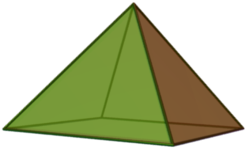Top Qs
Timeline
Chat
Perspective
Pentahedron
Polyhedron with five faces From Wikipedia, the free encyclopedia
Remove ads
In geometry, a pentahedron (pl.: pentahedra) is a polyhedron with five faces or sides. There are no face-transitive polyhedra with five sides, and there are two distinct topological types. Notable polyhedra with regular polygon faces are:
- Square pyramid with four triangles and one square.[1] Pyramids with any quadrilateral base have the same number of faces.
- Triangular prism with three rectangles and two triangular bases.[1] In the case of a right triangular prism, it is a special case of wedge with connecting parallel edges between triangles; the wedge generally has two triangles and three quadrilateral faces.[2] Topologically, the triangular frustum is the same polyhedron, but the two triangles are different sizes, and the sides are slanted trapezoids.
You can help expand this article with text translated from the corresponding article in Chinese. (February 2025) Click [show] for important translation instructions.
|
This article needs additional citations for verification. (March 2025) |
The pentahedra can be used as space-filling.[3][4]
Remove ads
Concave

An irregular pentahedron can be a non-convex solid: Consider a non-convex (planar) quadrilateral (such as a dart) as the base of the solid, and any point not in the base plane as the apex.
Hosohedron
There is a third topological polyhedral figure with 5 faces, degenerate as a polyhedron: it exists as a spherical tiling of digon faces, called a pentagonal hosohedron with Schläfli symbol {2,5}. It has 2 (antipodal point) vertices, 5 edges, and 5 digonal faces.
References
External links
Wikiwand - on
Seamless Wikipedia browsing. On steroids.
Remove ads


